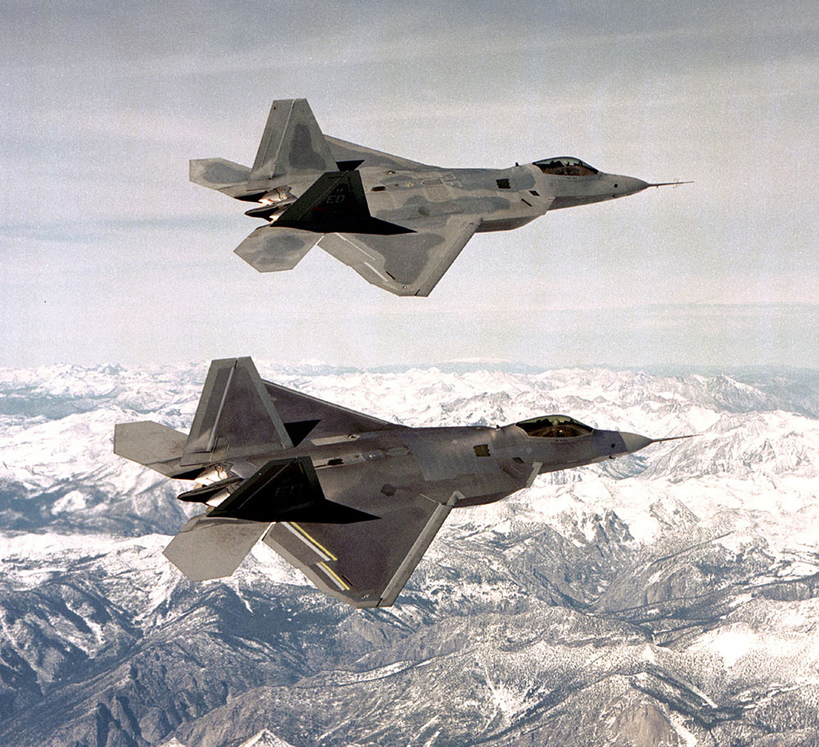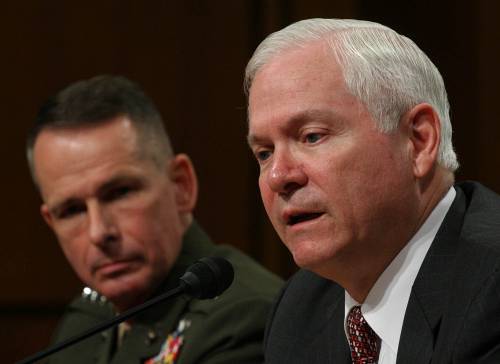How Not to Pass a Defense Bill
The $488-billion for defense was just tacked on to a larger spending bill at the last minute, with no separate vetting by appropriations committees. The lack of oversight leads to increased funding for programs repeatedly criticized by Defense Sec. Robert Gates.
Jul 31, 2020241.4K Shares3.4M Views
F-22 Raptors (Flickr: James Gordon)
The House Financial Services Committee, on Sept. 24, grilled Treasury Sec. Henry PaulsonJr. about the $700-billion financial bailout plan. The high-profile hearing signaled that lawmakers were not going to pass just any rescue bill before recessing to campaign.
But that same day, the House passed a bill almost as big — a $629-billion package titled the Consolidated Security Disaster Assistance and Continuing Appropriations Act of 2009. The legislation includes the Pentagon budget for next year.
The tab came to $488 billion — not including funding for the wars in Iraq and Afghanistan.
Illustration by: Matt Mahurin
Passing bills with little fanfare, including enormous defense budgets, is nothing new for Congress. But this defense appropriations bill is remarkable in a number of ways.
First, it never went through the appropriations committees in the House and Senate. Instead, the legislation was tacked on to the larger continuing appropriations bill a day before the House approved it. The bill is also remarkable because it increases funding for programs, like the F-22 fighter plane, that have been repeatedly criticized by Defense Sec. Robert Gates.
Gates and lawmakers from both parties have said Pentagon spending should be revamped. But that will likely have to wait at least another year.
“The legislative process was devoid of any reform,” said Winslow Wheeler, director of the Straus Military Reform Project at the Center for Defense Information, a non-partisan defense policy group. “To not even have a debate in the House or Senate was a cheapening of the process.”
Each year, Congress must pass 12 spending bills before Sept. 30 to keep the government running. As the Sept. 30 deadline approached, congressional leaders said they would only focus on the spending bills for the Dept. of Homeland Security, Veterans’ Affairs and the Pentagon. Money for the other nine bills would be part of a continuing appropriations act that would keep spending at current levels until March 2009.
But only the Veterans’ Affairs bill was debated in either chamber. So as part of the continuing appropriations act, the House added on that VA bill and also a Dept. of Homeland Security spending bill introduced last year.
Rep. John Murtha (Flickr: Matthew Bradley)
As the continuing appropriations act was about to hit the House floor, the top-ranking heads of the the House defense appropriations subcommittee, Reps. John Murtha (D-Pa.) and Bill Young (R-Fla.), hashed out a defense-spending bill. The legislation was not debated and voted on by the full appropriations committee but went straight to the House floor.
The continuing appropriations act sailed through the House, 370-58. Three days later, it cleared the Senate, 78-12.
The bill then bypassed the usual next step of being the subject of a conference report between the House and Senate because Murtha and Young had already struck a compromise with their counterparts in the Senate, Sens. Daniel Inouye (D-Hawaii) and Ted Stevens (R-Alaska).
“I’ve never, ever seen a case where the entire defense spending bill was voted on and passed largely unseen by Congress and not at least go through a committee,” said Steve Ellis, a spokesman for Taxpayers for Common Sense. “It was made available to Congress at 11 p.m. Tuesday; and was voted on Wednesday afternoon the next day.”
In response, Matthew Mozankey, a Murtha spokesman, said in an email that, “Of course we would have liked to have gone through the process. But that wasn’t how it worked out.”
Mozankey disputed the idea that the bill was “done overnight,” noting that the appropriations subcommittee discussed it in August and also consulted with the Senate.
President George W. Bush signed the continuing appropriations act, which boosts defense spending by 6.2 percent, on Sept. 30. But more remarkable than the overall $488 billion price tag is the money the legislation channels to future combat systems, missile defense and the F-22.
Both Republicans and Democrats criticized these programs during congressional hearings, and the Government Accountability Office, Congress’ auditing arm, unfavorably evaluated them.
But their most prominent critic has been Gates, who reportedly may bein the next administration’s Cabinet.
Secretary of Defense Robert Gates (WDCpix)
In numerous speeches and testimony before Congress, Gates has criticized the Pentagon as having “next-war-itis”– focusing on hypothetical future enemies instead of the current asymmetrical, insurgent threats in Afghanistan and Iraq.
“In a world of finite knowledge and limited resources, where we have to make choices and set priorities,” Gates said in Mayat the conservative Heritage Foundation, “it makes sense to lean toward the most likely and lethal scenarios for our military. And it is hard to conceive of any country confronting the United States in conventional terms.”
In that speech, Gates specifically cited the costs and delays of future combat systems, an elaborate, oft-criticized planto remake the Army through robotic and vehicle systems. But future combat systems got $26 million more in this year’s spending bill than the $3.6 billion requested by the Bush administration.
“Future Combat Systems marches on undisturbed,” said Wheeler, of the Center for Defense Information.
Perhaps no weapons systems has been as scrutinized aqs the F-22 fighter plane, first devised near the end of the Cold War to counter what some in the military saw as Soviet aircraft superiority. The first F-22, however, was not built until 2003, and Gates has questioned building more than the 183 planes already scheduled.
“We’re fighting two wars, in Iraq and Afghanistan,” Gates said at a February Senate Armed Services Committee hearing. “And the F-22 has not performed a single mission in either theater.”
But in this new bill the F-22 program got $523 million more than the $2.9 billion that the Bush administration wanted. “The subcommittee is looking at future threats,” Mozonkey said in an email, “not only our ability to respond, but our ability to deter and prevent war.”
Murtha has also recently citedthe conflict between Russia and Georgia as a reason to keep making weapons for the next war.
Mike Dunn, president and CEO of the nonprofit Air Force Assn., also evoked that conflict in defending the F-22. “If the president says, ‘set up a no-fly zone in Georgia,’ you need a F-22 to do that,” Dunn said.
But appeasing constituents with ties to the defense industry may have something to do with the F-22 spending increase. The plane is made by Lockheed Martin, as well as Pratt & Whitney, in Connecticut and Georgia. And Connecticut Rep. Rose DeLauro (D-Conn.) and two congressman from Georgia, Rep. Jim Marshall (D-Ga.) and Rep. Phil Gingrey (R-Ga.), were among the group of lawmakers that earmarked the extra F-22 money.
Funding for missile defense, another Cold War weapons system, dropped by about $200 million, from $8.9 billion $8.7 billion. But congressional earmarks for additional missile-defense projects totaled around $98 million. For example, Sen. Roger Wicker (R-Miss.) and Rep. Roy Blunt (D-Mo.) got $28 million for a short-range ballistic missile defense program called “David’s sling.”
The spending increases come as major defense contractors brace for cuts. Last week, Boeing CEO Jim McNerny wrote to employeesthat there will be “some measure of impact” from the bailout of the financial system on weapons procurement.
On the other hand, advocates for greater defense spending point out that what they asked for — and Congress and the president have provided — no longer seems as expensive when compared to the cost of bailing out the financial system.
“The government spent $1.3 trillion on Fannie [Mae], Freddie [Mac], a stimulus package that didn’t work and a big bailout,” said Dunn. “We’re just asking for a few billion to replace airplanes.”

Rhyley Carney
Reviewer
Latest Articles
Popular Articles



